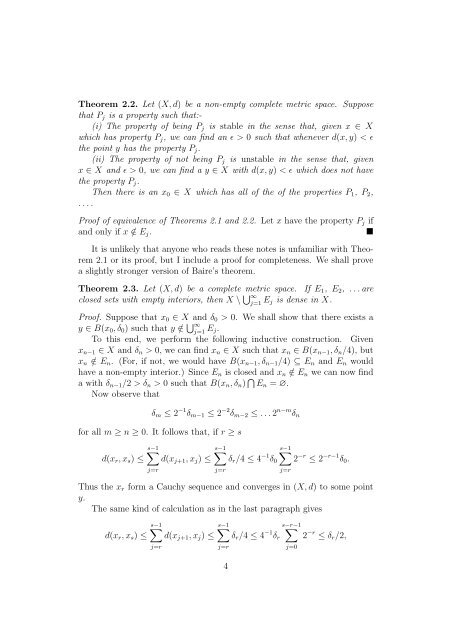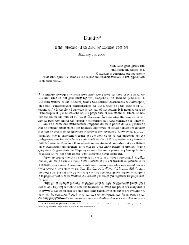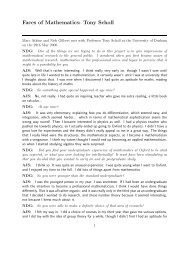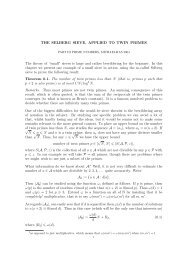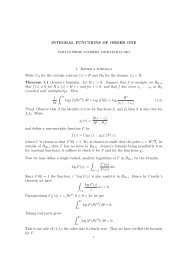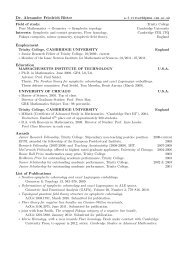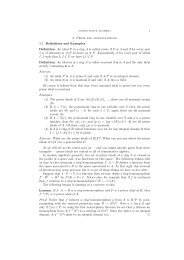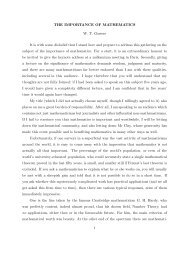Baire Category, Probabilistic Constructions and Convolution Squares
Baire Category, Probabilistic Constructions and Convolution Squares
Baire Category, Probabilistic Constructions and Convolution Squares
Create successful ePaper yourself
Turn your PDF publications into a flip-book with our unique Google optimized e-Paper software.
Theorem 2.2. Let (X,d) be a non-empty complete metric space. Suppose<br />
that Pj is a property such that:-<br />
(i) The property of being Pj is stable in the sense that, given x ∈ X<br />
which has property Pj, we can find an ǫ > 0 such that whenever d(x,y) < ǫ<br />
the point y has the property Pj.<br />
(ii) The property of not being Pj is unstable in the sense that, given<br />
x ∈ X <strong>and</strong> ǫ > 0, we can find a y ∈ X with d(x,y) < ǫ which does not have<br />
the property Pj.<br />
Then there is an x0 ∈ X which has all of the of the properties P1, P2,<br />
....<br />
Proof of equivalence of Theorems 2.1 <strong>and</strong> 2.2. Let x have the property Pj if<br />
<strong>and</strong> only if x /∈ Ej. <br />
It is unlikely that anyone who reads these notes is unfamiliar with Theorem<br />
2.1 or its proof, but I include a proof for completeness. We shall prove<br />
a slightly stronger version of <strong>Baire</strong>’s theorem.<br />
Theorem 2.3. Let (X,d) be a complete metric space. If E1, E2, ...are<br />
closed sets with empty interiors, then X \ ∞<br />
j=1 Ej is dense in X.<br />
Proof. Suppose that x0 ∈ X <strong>and</strong> δ0 > 0. We shall show that there exists a<br />
y ∈ B(x0,δ0) such that y /∈ ∞ j=1 Ej.<br />
To this end, we perform the following inductive construction. Given<br />
xn−1 ∈ X <strong>and</strong> δn > 0, we can find xn ∈ X such that xn ∈ B(xn−1,δn/4), but<br />
xn /∈ En. (For, if not, we would have B(xn−1,δn−1/4) ⊆ En <strong>and</strong> En would<br />
have a non-empty interior.) Since En is closed <strong>and</strong> xn /∈ En we can now find<br />
a with δn−1/2 > δn > 0 such that B(xn,δn) En = ∅.<br />
Now observe that<br />
δm ≤ 2 −1 δm−1 ≤ 2 −2 δm−2 ≤ ...2 n−m δn<br />
for all m ≥ n ≥ 0. It follows that, if r ≥ s<br />
s−1<br />
d(xr,xs) ≤<br />
j=r<br />
d(xj+1,xj) ≤<br />
s−1<br />
δr/4 ≤ 4 −1 s−1<br />
δ0<br />
j=r<br />
j=r<br />
2 −r ≤ 2 −r−1 δ0.<br />
Thus the xr form a Cauchy sequence <strong>and</strong> converges in (X,d) to some point<br />
y.<br />
The same kind of calculation as in the last paragraph gives<br />
s−1<br />
d(xr,xs) ≤<br />
j=r<br />
d(xj+1,xj) ≤<br />
s−1<br />
δr/4 ≤ 4 −1 δr<br />
j=r<br />
4<br />
s−r−1 <br />
j=0<br />
2 −r ≤ δr/2,


